Equal opportunities, but different messages. Imagine running a marathon where all participants wear the same size shoes, irrespective of their individual sizes. Counterproductive, right? Well, this is the simplistic analogy of traditional marketing practices. Recognize the diversity in your audience and deliver tailor-made messages to ensure everyone feels seen. Welcome to the era of inclusive marketing, the vibrant future of ad strategies.
Every day, companies churn out marketing content - billboards, newsletters, social media updates, enough to engulf our digital landscape in promotional clutter. Yet, not all messages resonate with every individual, and it’s no longer sufficient to embrace the one-message-fits-all approach.
Just as a successful marathon requires different shoe sizes, successful marketing in 2024 hinges on understanding and acknowledging audience diversity. This comprehensive guide decodes inclusive marketing strategies, because winning in today’s market means ensuring your message rings true to every customer, regardless of their individuality. Let’s chart a course through this exciting terrain, where the message is not just universal – it’s personal.
What is Inclusive Marketing?
Benefit Snapshot:
- Understand the definition and significance of inclusive marketing in the current business landscape.
- Learn about the evolution and current trends of inclusive marketing.
- Look into the forecasts for the future of inclusive marketing and how businesses can be prepared.
Definition and Importance
Inclusive Marketing isn’t some momentary buzz phrase – it’s a vital approach that influences how businesses communicate with their audiences. At its core, inclusive marketing acknowledges the diversity within market segments, and seeks to represent this reality in its messaging, be it in terms of:
- Race
- Gender
- Age
- Nationality
- Ability
The impact of inclusive marketing is potent in today’s interconnected world. By embracing diversity and inclusiveness, businesses are saying, “We see you, we understand you, and we value you,” an invaluable sentiment that bolsters brand loyalty and image.
Inclusivity in marketing is key to connecting authentically with diverse consumers.
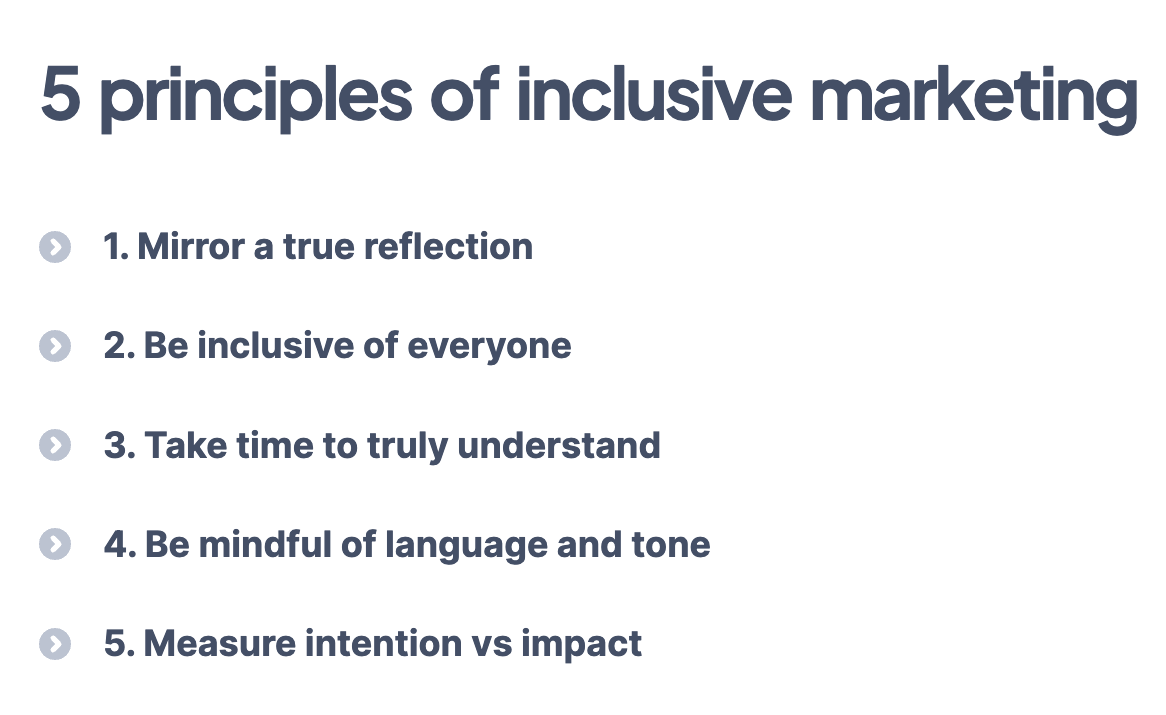
Evolution of Inclusive Marketing
Inclusive marketing wasn’t always the norm. The landscape has drastically morphed over the years, moving from historically homogenous portrayals to diverse and inclusive representations. This evolution hasn’t just occurred in the blink of an eye, but rather, it’s a reflection of societal changes and advancements.
Now, we witness a variety of trends in inclusive marketing, each with its unique spin but carry the same central theme: representation matters.
From diverse representation in advertising to multilingual content, the business world has finally caught on to the fact that inclusivity isn’t just ‘nice-to-have’ but a ‘must-have’ for successful communications.
The Power of Inclusive Marketing Strategies
- Identify the diverse nature of your audience
- Create content that represents every segment of your audience
- Choose marketing channels that reach all audience corners
Step 1: Understand Your Diverse Audience
Every successful campaign begins with a clear understanding of the audience. Knowing your audience has paramount significance. It helps tailor messaging that resonates on an emotional and cultural level, fostering a strong customer connection.
A deep insight into the diversity of your audience illuminates nuances that are often overlooked by one-size-fits-all marketing strategies. Engaging with a diverse audience is no exception. The first step in setting up an inclusive marketing strategy is unravelling the mosaic of your audience’s diversity.
How to Gather Data About Your Audience’s Diversity
To gather detailed information about your audience’s diversity you need to use robust tools like:
- Market research: Conducting basic research into your market creates the building blocks for the rest of your strategy. Consider creating a buyer persona to focus your efforts going forward.
- Surveys: Before launching inclusive marketing campaigns, surveys can be a fantastic way to gain a deeper understanding of your audience from them themselves. Observation and analytics are helpful, but information from your ideal customers is incredibly valuable.
- Social media analytics: Social media is an incredible tool to tap into when you want to learn about your audience. Identify the platform where your target customers will likely hang out and then deep dive into the analytics.
This knowledge base can fuel an inclusive marketing strategy that features every customer, producing stronger brand affinity.
Step 2: Creating Inclusive Content
The most effective message is the one that speaks to the audience directly. Democratize brand building with Inclusive content – it delivers such message. A message that resonates with everyone, regardless of their backgrounds or life experiences. Let’s dive into creating inclusive content for your business.
Importance of Representation in Marketing Content
Representation in marketing content reaffirms a brand’s commitment to diversity. When your audience sees themselves mirrored in your campaign, they feel:
- Acknowledged
- Validated
- Engaged with your brand
Inclusive content portrays a world where everyone matters, and everyone’s voice is heard. From using diverse visuals to implementing inclusive language, there are myriad ways to create content that connects with every audience member.
A good starting point could be to address different cultural, racial or gender identities in your content. Simultaneously, ensure that these representations are accurate, respectful and not rooted in stereotypes.
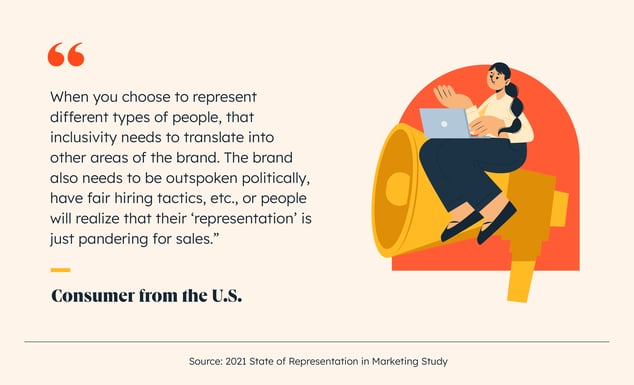
Step 3: Implementing Inclusive Marketing Channels
With an arsenal of inclusive content, developing diverse marketing channels is the next step. This ensures the content reaches everyone in your audience, regardless of their online habits or technological accessibility.
Each marketing channel has a distinct set of demographics. To ensure your brand message reaches every corner, using a diverse array of channels is crucial.
How to Choose the Right Channels for Your Audience
Understanding where your diverse audience spends their online time is the key to choosing the right marketing channels. Along with demographics, consider the audience’s online behaviour patterns and the nature of your product/service. For example:
- LinkedIn: This platform is a fantastic place for creating marketing campaigns aimed at professionals. For example, SaaS products and services. Content that performs best on LinkedIn includes thought leadership posts, long-form articles, and interactive content with the audience.
- Instagram: Inclusive marketing aims to connect with your audience on a personal level, this is when influencer marketing can be incredibly effective. Instagram’s platform is the perfect space to reflect your audience in sponsored ads and influencer content.
- Website: Sometimes, the best channel is focusing on your own website’s visibility. This means you can create marketing campaigns focused on SEO and long-form content to attract people organically to your site. This is a good option if your audience don’t spend a lot of time on social media.
Each step of this guide aims to cultivate a more comprehensive and inclusive marketing strategy. By understanding the diversity of your audience, creating representative content and utilising various channels, your marketing strategies can reach new heights of inclusivity and effectiveness.

Reaping the Benefits of Inclusive Marketing
A competitive spectrum of wins is up for grabs when firms take bold steps to realign their marketing with inclusivity at its core.
- Achieve a strong foothold of loyal customers and brand advocates
- Unlock access to a broader customer base and solidify your market presence
Increased Brand Loyalty
When brands speak universally and exhibit an embracing attitude, they turn a casual customer into a dedicated brand crusader. It weaves a unique fabric of brand belief, establishing a personal touch and a sense of belonging among consumers.
Companies like Dove, with their “Real Beauty” campaign, demonstrated the powerful impact of inclusivity. Their campaign included an emotional video that showed a forensic artist who drew an image of a woman based on that woman’s description of themselves.
They then asked their friend for another description of the same woman. The difference in the drawings showed how self critical we can be and the beauty that others see in us.
It reached out to women of all shapes, sizes, and colors, and connected them on a deeper level of self love. By doing this, Dove fostered an unmatched brand loyalty.
When Inclusivity Expands Market Reach
Leaning on inclusivity isn’t just about securing brand loyalty. It’s also a potent tool for propelling your brand to new and unaccessed corners of the market labyrinth.
Why? Because inclusive marketing erases barriers. By communicating in an accessible, broad-minded way, brands can establish relevance across an expanding, heterogeneous consumer base.
Brands like Airbnb are proving that inclusive marketing can be a game-changing strategy for enhancing market penetration. By running campaigns that celebrated diversity, Airbnb managed to tap into a global audience and prove a lodestar for other brands. Their most notable was the ‘We Accept’ campaign that created an Airbnb community that was inclusive and diverse.
Where brand loyalty boosts customer retention, market reach enhances brand discovery. Together, they make inclusive marketing an incredibly potent tool for brand growth and endurance.
This potent mix, blending inclusivity with strategic thinking and authenticity, holds promise for elastic growth and brand deployment. What you stand to gain by fully embracing inclusive marketing is a resilient bond with your audience and an ever-expanding loyal customer base.
Understanding the Impact of Inclusive Marketing
- Influence on consumer perception
- Correlation with business performance
On Consumer Perception
In the sphere of marketing, the inclusive approach is rapidly becoming the golden standard. Its fundamental principle revolves around valuing and representing all diverse groups in a substantiated and accurate manner. This approach significantly influences consumer perception.
An inclusive marketing strategy that weaves diverse narratives more effectively engages consumers. It makes them feel:
- Heard
- Seen
- Valued
The image and reputability of the brand showcasing inclusivity amplifies its reach, encouraging loyalty and creating a sense of belonging among consumers.
Moreover, embracing diversity in marketing tends to make products or services more relatable, leading to an increase in consumer interest and purchase intent. Inclusive marketing emerges as a reliable tool to resonate with the rapidly evolving, diversifying consumer base.
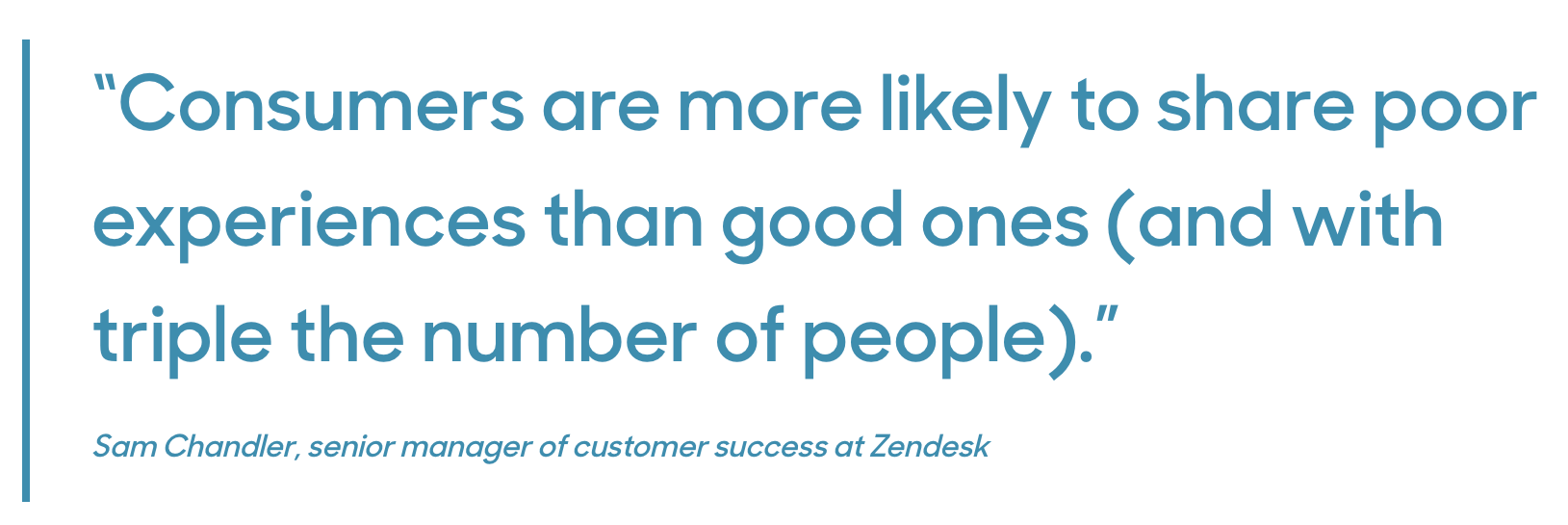
Studies Showing the Impact of Inclusive Marketing on Consumer Perception
Studies substantiate the impressionability and positive impact of inclusive marketing on consumer perception. When 36% of people have boycotted a brand because of problems with diversity and inclusivity, it’s clear how important it is to get your inclusive marketing campaign right.
A recent research report points out that brands promoting diversity and inclusivity are perceived more favorably, captivating higher consumer trust and loyalty. In fact, 57% of consumers are more loyal to brands that commit to addressing social inequality.
These studies underline the relevance and effectiveness of inclusive marketing, emphasizing its importance in modern-day marketing strategies. Businesses showing commitment to inclusive marketing enjoy a wider consumer base, paving the way to a more comprehensive market presence.
On Business Performance
In addition to reshaping consumer perception, inclusive marketing can have a profound impact on overall business performance. It is a pathway continually leading to new market segments and opportunities. The following two examples show how inclusive marketing can boost your business:
- Inclusive marketing strategies can open doors to untapped markets: This offers businesses opportunities to craft engaging narratives that resonate with a variety of audiences, broadening their reach and traction, contributing to an increase in revenue.
- Representation of diverse groups in advertising enhances brand image: This attracts talent towards a business that aligns with their values, increasing visibility and inclusivity which can significantly boost staff retention and team morale, leading to higher productivity.
Data Showing the Correlation between Inclusive Marketing and Business Performance
A 2019 study by McKinsey & Company states that inclusive companies were likely to have higher cash flow, outpacing their competitors. The study emphasized that companies that embed inclusivity in their brand narrative make 83% better decisions, contributing to increased performance.
Here are some key findings from multiple sources that validate and expand upon this claim:
- Diversity as a Financial Advantage: Research by McKinsey & Company has shown that companies with ethnically diverse management teams were 35% more likely to financially outperform their industry means. This emphasizes the correlation between diversity and superior financial performance.
- Innovative Revenue Growth: Companies that embrace diverse management teams also see a 19% higher revenue from innovation, suggesting that diversity fosters creativity and leads to better ideas.
- Enhanced Cash Flow: A study highlighted that companies with a diverse workforce enjoy significantly higher cash flow per employee. This is particularly notable for smaller companies, which saw as much as 13 times higher cash flow.
- Improved Team Dynamics: Highly diverse and inclusive organizations report 26% more team collaboration and 18% more team commitment compared to non-inclusive organizations.
- Better Decision Making: Teams that follow an inclusive process make decisions twice as fast with half the meetings, and decisions made by diverse teams delivered 60% better results.
- Increased Retention: Inclusive companies are more likely to retain Millennials and other employees for more than five years, suggesting a direct impact on reducing turnover costs.
These findings collectively underscore the importance of integrating DEI not just as a marketing approach but as a foundational business strategy. By focusing on creating a genuinely inclusive environment, businesses can not only enhance their brand’s appeal but also leverage diversity as a key driver of innovation, employee satisfaction, and financial performance.
To make a difference in consumer perception and business performance, inclusivity must be more than merely marketing chatter. It should be a deep-seated business ethos, mirrored in every marketing message and business effort. This authentic approach will turn inclusivity into a true business asset.
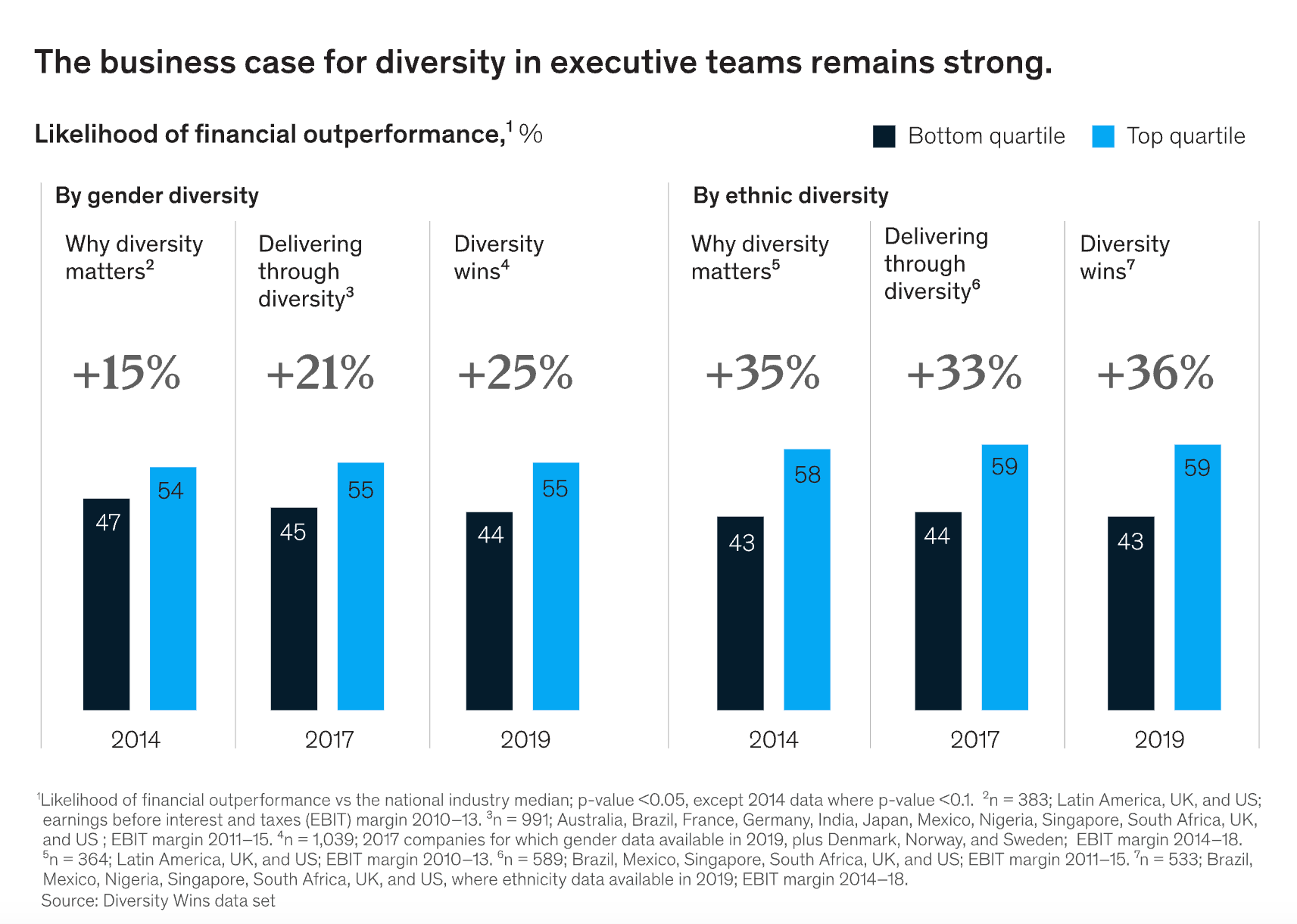
Best Practices for Inclusive Marketing
TL;DR:
- Authentic representation contributes to the overall success of inclusive marketing
- Continuous learning and self-improvement are the keys to maintaining sustainable inclusive marketing
Inclusive marketing strategies are about reaching and engaging a diverse audience. It’s about acknowledging and valuing their unique perspectives. Following best practices can quadruple the benefits.
Authentic Representation
Capturing the essence of diverse experiences helps to build genuine connections. Authentic representation influences the virality of your campaigns and boosts customer loyalty.
1 in 3 customers stop buying brands due to the lack of representation in their campaigns. Authentic representation solidifies user relationships and creates a lasting bond with your brand. Being seen and heard directly translates into brand loyalty, higher engagement, and increased sales.
Achieving authentic representation requires a profound understanding of your audience. Here are a few steps to consider:
- Conduct extensive audience research: Learn about their cultural backgrounds, interests, and experiences.
- Collaborate with diverse teams: Diverse teams deliver diverse solutions. Having a team with varying backgrounds can provide unique insights and ideas.
- Tell relatable stories: Users connect more with stories that reflect their experiences and aspirations.
Continuous Learning and Improvement
Inclusive marketing is not a one-and-done task. It’s an ongoing process of learning, adapting, and improving. By keeping yourself open to feedback and continuously enhancing your approach, you ensure that your strategies remain impactful and relevant over time.
Companies adopting inclusive marketing should understand that it’s a journey, not a destination. Often, it’s not about being the best, but rather about doing better each day.
How can you incorporate feedback and improve your inclusive marketing efforts? Here are some guidelines:
- Be open to criticism: Not all feedback will be positive. Learn to accept harsh criticisms and use them to improve your marketing efforts.
- Regularly update your strategies: As your audience evolves, so should your strategies. Be prepared to adjust your plans based on changes in your audience’s needs and interests.
- Invest in developing your team: Make sure that your team members are well-equipped to carry out inclusive marketing strategies. Offer training sessions, workshops, and seminars to upgrade their skills.
Remember, Inclusive marketing is more than just showcasing diversity-it’s about nurturing a sense of belonging among your users. By being thoughtful with your representation and continuously adapting your strategies, you can Lead your marketing game towards inclusivity and success.
Inclusive Marketing Case Studies
- From theory to action: Learn from real-life examples.
- Witness the tangible results of inclusive marketing.
- Understand brands’ pathways to successful inclusive strategies.
Case Study 1: Savage X Fenty by Rihanna
Rihanna’s Savage X Fenty revolutionized the lingerie industry by showcasing body inclusivity. Unlike traditional fashion shows focusing on a single body type, Savage X Fenty featured models of various sizes, shapes, and ethnic backgrounds, challenging industry norms and celebrating diversity. This approach not only expanded their market reach but also fostered a strong brand loyalty among consumers who felt represented.
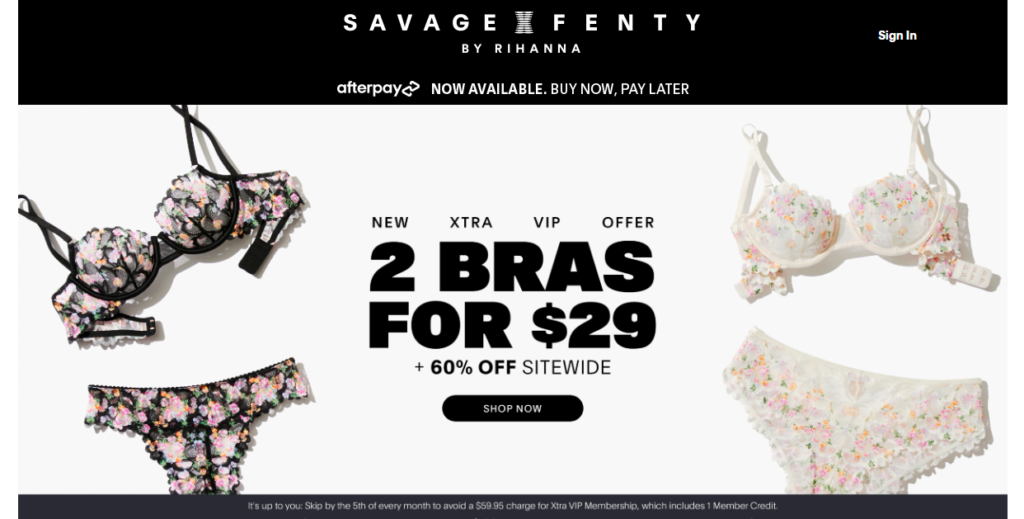
Inclusive marketing is not a tool for virtue signaling but demands tangible business results. The versatile Savage X’s strategy paid off in several ways, realizing a rise in brand loyalty and higher customer satisfaction rates, amassing a more diverse consumer base that felt seen.
While the immediate monetary returns were grand, the long-term impact was significant, instilling a sense of trust and dependability in their consumers.
Case Study 2: Gillette Ad Featuring a Trans Teen
Gillette’s ad featured a trans teen experiencing his first shave with his father, touching on a significant moment for many in the transgender community.
The campaign was praised for its authentic representation and sensitivity, highlighting Gillette’s commitment to all men, including those from the trans community. This move was a significant step toward inclusivity, resonating with a broader audience and enhancing brand perception.

Global News featuring Gillette Ad
On the surface, the impact of Gillette’s inclusive strategies was a remarkable gain in the market share and increased profitability. But what lies beyond is the transformational shift in their brand perception. The brand deeply ingrained itself into the lives of their audiences, not just as a product or a service provider, but as a progressive entity free from limiting biases and recognizing their individuality.
Future of Inclusive Marketing
As we look ahead, the trend of inclusive marketing only escalates in importance. It’s no longer an option, but a necessity for businesses intending to thrive in an increasingly diverse world. However, the future isn’t some distant possibility-it’s arriving every day, and businesses must be ready to adapt.
The focus will likely shift from simply ‘including’ diversity to weaving it seamlessly into every facet of a company’s operations and communications. It’s anticipated to become a benchmark of corporate responsibility. In preparation for these shifts, commitment to constant learning, understanding, and evolution are pivotal. This includes upskilling teams, analyzing consumer behavior, and revising strategies accordingly.
Vision for an Inclusive Future: Your Role Starts Now
We’ve navigated through the maze of inclusive marketing, shedding light on its deep-seated potency and charting the major strategies for efficient execution.
Undeniably, embracing inclusive marketing in 2024 doesn’t just make business sense; it’s a path to authenticity and a broader and more loyal customer base. Your brand can become a beacon of inclusivity, a catalyst for change in a diverse world craving representation.
Your business is ready to implement inclusive initiatives now. Start by auditing your current strategy, revising it with a keen eye for inclusivity. From there, the world is your oyster. Create campaigns that celebrate diversity. Remember, measurement and continuous refinement are key to maintaining inclusivity in your marketing.
Thinking about your existing marketing strategy, where do you see opportunities for more diverse representation? That’s the perfect starting point.
With it, you won’t just be part of the future; you’ll be actively shaping it. This isn’t just marketing; it’s creating ripples of impact in a sea of sameness. You have the power to make a difference. Use it.
Inclusive Marketing FAQ
Q1: What is inclusive marketing?
Inclusive marketing is the practice of developing marketing strategies and content that acknowledge and address the diversity of the audience, including all demographics and backgrounds.
Q2: Why is inclusive marketing important?
Inclusive marketing is important because it ensures that diverse groups feel seen and valued, which can enhance brand loyalty, reach, and overall brand perception.
Q3: How can I identify my diverse audience?
Identify your diverse audience through market research, surveys, and analysis of social media and other customer data.
Q4: What makes content inclusive?
Inclusive content represents a variety of backgrounds, experiences, and perspectives, and addresses a broad range of customer needs and interests.
Q5: How do I choose the right marketing channels for an inclusive strategy?
Choose channels based on where your diverse audience spends their time and how they consume media, ensuring accessibility for all.
Q6: Can inclusive marketing improve my business performance?
Yes, inclusive marketing can expand your market reach, improve customer loyalty, and enhance brand reputation, contributing to better business performance.

